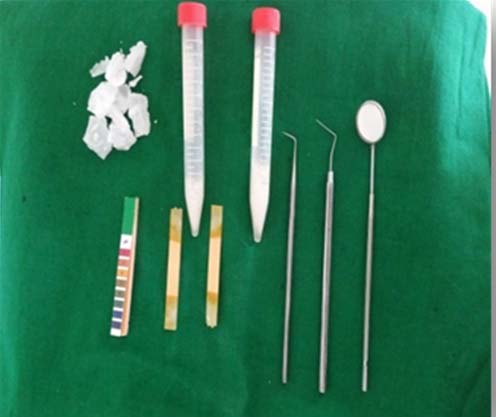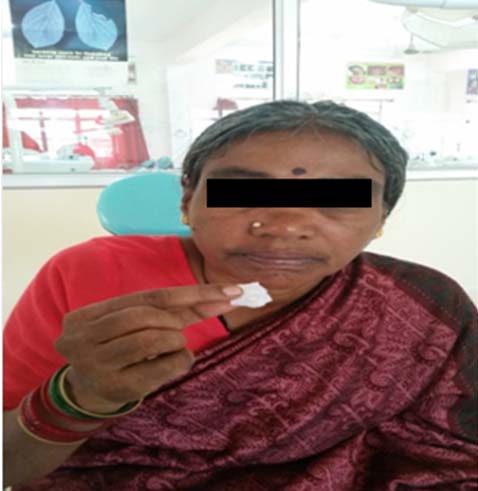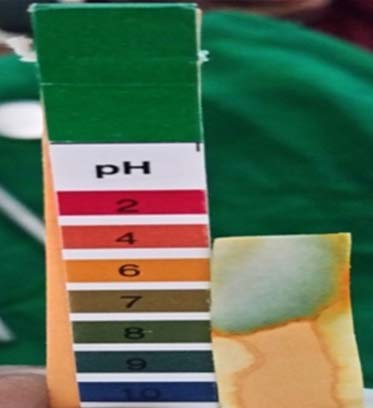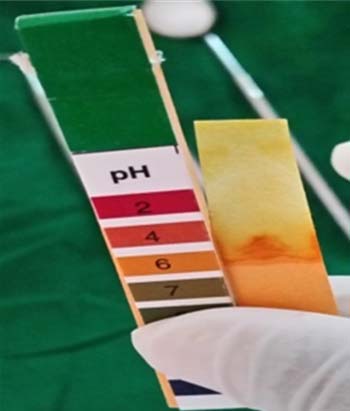Saliva is important in the maintenance of oral health by exhibiting numerous host defense functions such as lubrication, anti-microbial activity, control of mineralization potential of teeth and others [1]. The unstimulated salivary flow rate is 0.1-0.3ml/min, with an average total of 16 hours of unstimulated saliva flow being 300 ml with a pH 7.2 -7.4 [2]. Salivary flow rate during sleep is nearly zero. The maximum stimulated salivary flow rate is 1.5-7ml/min. 80-90% of the daily salivary secretion is produced by stimulated saliva [3].
This miraculous fluid of oral cavity also reflects the systemic condition of an individual. Hypo-salivation is seen in patients with renal problems, hypertension, and diabetes. Significant changes in salivary output and its composition are also seen in anxiety, depression disorders, stress and other systemic diseases [4]. Hypertension is a highly prevalent cardiovascular disease, which affects over 1 billion people worldwide. Although more than 70% of hypertensive patients are aware of the disease, only 23.49% are treated, and fewer (20%) achieve control. Hypertension is defined as systolic and diastolic blood pressures with values >140mmHg and >90mmHg respectively, the prevalence of which varies by age, race, and education [4]. Saliva is gaining popularity as a diagnostic tool for evaluating physiologic and pathologic conditions by virtue of its ease of collection method, non-invasiveness and low cost [5,6]. Thus, the aim of the present study was to evaluate the influence of hypertension on pH of saliva, saliva flow rate in elderly individuals and correlating it with oral health status.
Materials and Methods
The cross-sectional study included 40 elderly individuals of age between 60-75 years, who came with various dental problems to the Department of Oral Medicine and Radiology, Meghna Institute of Dental Sciences, Nizamabad, Telangana, India. A pilot study was first conducted and the statistics were sent to statistician who then determined the sample size for the present study. Ethical clearance was taken from the ethical clearance committee and written consent was taken from all the patients before start of the study. They were divided into two groups: Group A- 20 individuals who were hypertensive and using anti-hypertensive medication; Group B- 20 patients without hypertension and have not used any medication. A detailed medical history and clinical examination was done and oral health status was evaluated by recording the number of teeth present, bleeding on probing, probing depth, gingival recession, clinical attachment loss and oral hygiene index. [Table/Fig-1] depicts the armamentarium used in the study.
Armamentarium used for the study.

Collection of Saliva [Table/Fig-2,3 and 4]: Patients were instructed not to eat or drink 2 hours before the collection of saliva and they were made to sit comfortably in inclined position on dental chair in relaxed state. Unstimulated saliva was collected in graduated tubes. Then flow rate was measured for every 1min for 5 minutes and pH was measured using pH indicating papers (Finar Chemicals Limited). Stimulated saliva was collected by asking the patient to chew paraffin wax and then restrain the saliva into graduated test tube, flow rate was measured for every 1min for 5 minutes and pH was measured using pH papers. Gingival bleeding was recorded by gently probing the gingival sulcus using a probe. Individuals with bleeding on probing from more than 30% of the teeth were considered as bleeding on probing present. Periodontal probe was used to measure the loss of attachment and depth of pocket. Oral hygiene was recorded using simplified oral hygiene index, which included two components i.e., debris index and calculus index [7].
Method of collection of saliva.

Litmus paper showing basic pH.

Litmus paper showing acidic pH.

Inclusion Criteria: Older adult co-operative patients only on anti-hypertensive medication for hypertension were included in the study group. Age and gender matched healthy co-operative older adults without hypertension and not using any anti-hypertensive medication and willing to participate in the study were taken as the control group.
Exclusion Criteria: Patients with systemic diseases and on medications for the same were excluded. Specific diseases that affect the salivary output/composition like diabetes mellitus, Sjogren’s syndrome, malignancies and its complications were also excluded. The obtained values were sent for statistical analysis, where unpaired t-test was used for the comparision of stimulated and unstimulated salivary flow rates and pH between control and study groups, chi-square test was used for comparision of presence or absence of bleeding on probing, periodontal pockets, clinical loss of attachment between control and study group.
Results
Mean comparison of stimulated and unstimulated salivary flow rates and pH between control and study group is shown in [Table/Fig-5]. Comparison of bleeding on probing between control and study group is shown in [Table/Fig-6]. Among 20 individuals in control group only 12 individuals had bleeding on probing, where as in study group all the 20 individuals had bleeding on probing and as the p-value is <0.05 it was considered as significant.
Comparision of SSFR, USSFR, SSpH and USSpH between control and study group.
| Variable | Groups | Mean | SD | Mean±SD | T value | p-value |
|---|
| SSFR | Control group | 3.30 | 0.70 | 0.33±0.05 | 1.530 | 0.134NS |
| Study group | 3.63 | 0.65 |
| USSFR | Control group | 2.73 | 0.68 | 0.15±0.31 | 0.867 | 0.391NS |
| Study group | 2.58 | 0.37 |
| SSpH | Control group | 6.50 | 0.69 | 0.55±0.14 | 2.228 | 0.028S |
| Study group | 7.05 | 0.83 |
| USSpH | Control group | 5.75 | 1.12 | 0.70±0.11 | 1.880 | 0.068NS |
| Study group | 5.05 | 1.23 |
Statistical Analysis: Unpaired t test. Statistical significance at p<0.05. (SSFR - stimulated salivary flow rate, USSFR- unstimulated salivary flow rate, SSpH- stimulated saliva ph, USSpH- unstimulated saliva pH, NS-non-significant, S-significant, SD-standard deviation).
Comparision of bleeding on probing between control and study group.
| Bleeding onProbing | Presentn(%) | Absentn(%) | Totaln(%) |
|---|
| Control group | 12(60.0) | 8(40.0) | 20 (100.0) |
| Study group | 20 (100.0) | 0(0.0) | 20 (100.0) |
Statistical Analysis: Chi-square test. Chi-square value=10.000, p-value=0.002.
Number of teeth having periodontal pocket >3mm and frequency comparison between control and study group is shown in [Table/Fig-7]. The number of individuals having pockets is same in both study and control group i.e., 20. But the number of individuals having pocket depth more than 3mm was more in hypertensive patients and as the p-value is less than 0.05, it was considered as significant. Number of teeth having clinical loss of attachment >5mm and frequency comparison between control and study group is shown in [Table/Fig-8].
Comparision of number of teeth having pockets > 3mm between control and study group.
| No. of teeth | Control groupn(%) | Study groupn(%) |
|---|
| Code 0 | 0(0.0) | 12 (60.0) |
| Code 1 | 6 (30.0) | 1 (5.0) |
| Code 2 | 8 (40.0) | 5 (25.0) |
| Code 3 | 6 (30.0) | 2 (10.0) |
| Total | 20 (100.0) | 20 (100.0) |
Statistical Analysis: Chi-square test. Chi-square value=18.264, P value=0.000. Code 0: no pockets, Code 1: pockets >1mm, Code 2: pocket >2mm, Code 3: pockets >3mm; n is the number of individuals.
Comparision of clinical loss of attachment between control and study group.
| No. of teeth | Control group n(%) | Study groupn(%) |
|---|
| Code 0 | 7 (35.0) | 1 (5.0) |
| Code 1 | 0 (0.0) | 0 (0.0) |
| Code 2 | 8 (40.0) | 6 (30.0) |
| Code 3 | 5 (25.0) | 6 (30.0) |
| Code 4 | 0 (0.0) | 5 (25.0) |
| Code5 | 0 (0.0) | 1 (5.0) |
| Code 6 | 0 (0.0) | 1 (5.0) |
| Total | 20 (100.0) | 20 (100.0) |
Statistical Analysis: Chi-square test. Chi-square value=11.877, p-value=0.008
Oral hygiene index comparison between control and study group is shown in [Table/Fig-9].
Comparision of oral hygiene index between control and study group.
| OHI | Control groupn(%) | Study groupn(%) |
|---|
| Good | 7 (35.0) | 5 (25.0) |
| Fair | 11 (55.0) | 13 (65.0) |
| Poor | 2 (10.0) | 2 (10.0) |
| Total | 20 (100.0) | 20 (100.0) |
Statistical Analysis: Chi-square test. Chi-square value=0.500, p-value=0.779; OHI- oral hygiene index.
Discussion
One of the most prevalent systemic conditions among the elderly individuals is hypertension but very little is known with respect to the influence of hypertension on oral health and function. Forty elderly adults who were divided into two groups as described above were taken into the study. Stimulated and unstimulated saliva were collected to measure the flow rate and pH. Unstimulated whole saliva plays a key role in protecting the oral tissues representing the salivary gland status and is considered to be present for about 14 hours a day [8]. Whereas, stimulated saliva which is present in the oral cavity for about 2 hours a day represents the secretion during food intake (physiologic stimulation), indicating the functional reserve of the gland. In our study we had chosen to measure both stimulated and unstimulated saliva in order to evaluate both i.e., gland status and functional reserve [9].
Study showed significant association of hypertension/anti-hypertensive medication with salivary pH and oral hygiene index. In our present study there was no significant difference in the salivary flow rates between normotensive and hypertensive individuals which was similar to study done by Streckfus CF et al., and Niedermeier W et al., [4,10].
A significant decrease in stimulated salivary pH was seen in our study, which can be attributed to xerostomia caused by decreased fluid volume and loss of electrolytes secondary to increased urination and dehydration in study group [11].
Bleeding on probing was significant in the study group, which is in accordance with the study done by Leye M et al., in 2014 [12]. A nationwide survey in United States by Tsakos G et al., also showed significant association between gingival bleeding and hypertension in adults. A significant increase in the incidence of periodontal pockets and clinical attachment loss was seen in study group in comparison with the control group, which could be due to increased release of markers of inflammation like, C - reactive protein and proinflammatory cytokines in hypertensive individuals [13]. The present study was also in accordance with Engstrom S et al., who found significant association of hypertension with periodontal pocket of greater than or equal to 5mm [14].
The study group showed the oral hygiene index values which were not significant as few elderly adults maintained their oral hygiene well despite the use of medications which is contrary to study done by Leye M et al., in 2014, which showed a significant association between oral hygiene index and hypertension [12].
Salivary performance for similar medical conditions may not be same in all. However, according to Ship JA et al., the values for stimulated salivary flow rate among hypertensive persons do coincide with the range of normal values [15]. Thus, longitudinal studies with emphasis on stages of hypertension would be more conclusive in determining the normal salivary flow rates and pH and its effects on oral structures.
Limitation
Limitation of the study is that it was carried on a very smaller sample size for shorter duration of the time. Better correlation between hypertension and salivary flow rate, pH and oral hygiene status could have been obtained if the study has been carried on larger sample size for longer duration in different stages of hypertensive patients using different types of anti-hypertensive medications.
Conclusion
It is imperative from our study that hypertension and use of anti-hypertensive medications has definitive effect on pH of stimulated saliva which can be attributed to many oral detrimental changes. We did not observe any association of this systemic disease on salivary flow rates which do not preclude its effect on it, rather more research with longitudinal type of study design would be needed for confirming the flow rate alterations in hypertensive patients. Hence, there is a necessity to monitor blood pressure for reconstruction and maintenance of oral health in elderly adults.
Statistical Analysis: Unpaired t test. Statistical significance at p<0.05. (SSFR - stimulated salivary flow rate, USSFR- unstimulated salivary flow rate, SSpH- stimulated saliva ph, USSpH- unstimulated saliva pH, NS-non-significant, S-significant, SD-standard deviation).Statistical Analysis: Chi-square test. Chi-square value=10.000, p-value=0.002.Statistical Analysis: Chi-square test. Chi-square value=18.264, P value=0.000. Code 0: no pockets, Code 1: pockets >1mm, Code 2: pocket >2mm, Code 3: pockets >3mm; n is the number of individuals.Statistical Analysis: Chi-square test. Chi-square value=11.877, p-value=0.008Statistical Analysis: Chi-square test. Chi-square value=0.500, p-value=0.779; OHI- oral hygiene index.